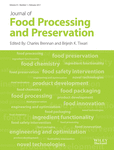New Perspectives for the Encapsulation of Hydrophilic Compounds
Abstract
Encapsulation of a hydrophilic extract was performed with complex coacervation and immobilization into the gel matrix to compare the encapsulation efficiency. Sodium alginate and gelatin suspensions containing different ratios of maltodextrin were selected as the wall material for cross-linking and immobilization, respectively. Olive leaf extract was chosen as the core material. The mixtures were injected as droplets in the solution of calcium chloride and oil bath with syringe pump. Several characteristics including particle volume, swelling rate, microstructure and release profiles at gastric pH 1 and intestinal pH 7.4 at 20 and 37C of the gelled beads were determined. Encapsulation efficiency of cross-linked and gelled beads were 31.12 ± 0.75 to 44.66 ± 0.78% and 94.28 ± 0.46 to 98.64 ± 1.08%, respectively. Statistical analysis of the results revealed that the effect of maltodextrin content on particle volumes, swelling rates and release rates was significant. Additionally, the release rate was significantly affected from temperature and pH.
Practical Applications
Oleuropein extraction process from olive leaf was performed effectively and practical according to the most of method. Therefore, it is available for analysis and large-scale extraction processes. In process of encapsulation of hydrophilic compounds, low yield by cross-linking and high efficiency by immobilization were demonstrated. And, some properties of the beads (encapsulation efficiency, particle size, swelling rate, microstructure and release profiles) which produced by immobilization were analyzed. The obtained data from this study is thought to be guiding for food industries, nutraceutics production and pharmacy. High efficient cross-linking process for hydrophilic components could be improved.




